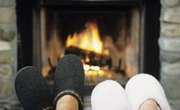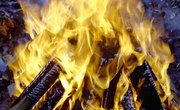
The amount of smoke generated by firewood depends largely on what type of wood you use. If you depend on wood fires to heat your home, you want a wood that will burn a long time and produce plenty of heat. Factors other than what type of wood you're burning can contribute to how smoky your fire is.
Hardwoods
Due to the high density of plant cells in hardwoods, they tend to burn hotter and therefore produce less smoke than softer woods that have lower cellular densities. Hardwoods also burn for longer periods. Examples of low-smoke hardwoods include almond, apple, ash, oak, beech, birch, cherry, dogwood, hickory, maple, oak, pecan, walnut. Slightly smokier hardwoods include aspen, elm, basswood, cottonwood, gum (eucalyptus), sycamore and yellow poplar.
Softwoods
Most conifers fit into the category of softwoods. The plant cells are larger and not as tightly packed as the cells in hardwoods, and softwoods burn more rapidly, produce less heat and often create more smoke than the harder woods. Included among the softwoods are cypress, eastern red cedar, fir, spruce and southern yellow pine.
Sap Content
Many softwood trees, and a few hardwoods, produce pitch, or tree sap, which the trees use to heal wounds. When something penetrates the bark, or if a branch breaks, pitch seeps from the wound. Once in contact with the air, the pitch hardens, and forms a natural bandage. This sap is highly volatile and any pitch-producing tree will therefore emit a considerable amount of smoke when used as firewood. Some examples include the cedar, fir, most varieties of pine and the sugar maple.
Wet Wood
Wet wood cannot burn hot, and a hot fire is the key to reducing the amount of smoke produced. Any species of wood, when wet, will not catch completely until it dries out. Much of the excessive smoke emitted by wet wood is actually steam mixed with small particulate matter. Season firewood properly and keep it out of the rain.
Smoldering vs. Burning
The hotter a fire burns, the less smoke it produces. Hardwoods emit less smoke than do softwoods because the hardwoods burn hotter. Even softwoods need not create excessive amounts of smoke. Common fire building mistakes include using too little firewood or to clumping pieces of wood too closely together. Both of these practices can cause the wood smolder rather than burn. Leave several inches of space between your pieces of burning firewood and stack the firewood so that the pieces have minimal contact with one another. One effective strategy when starting a fire is to stack the wood in a log cabin configuration.
References
Writer Bio
Tom Wagner began writing for newspapers and magazines in the L.A. area in 2001. With articles appearing in "California Examiner," "World Reporter," the "Philippine Nurses Monitor" and "Famegate Global News," he currently writes for all three Philippine Media publications in Los Angeles, San Diego and Las Vegas. His articles focus on food, social issues, travel, sight-seeing, humor, general information, politics and medical matters.



